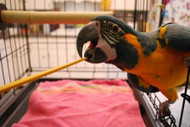Parrot Training And Handling Guidelines
Posted by Parrot Training And Handling Guidelines, Parrot training, Parrot handling, holding Parrots on 26/3/2025
Here are Parrot training and handling guidelines for you.
Susan Friedman, PhD and I developed these guidelines to use when involved in a training session with your bird. We have been fortunate to teach a number of workshops with hundreds of Parrots and have applied these strategies with good success. We hope you will find them useful.
Parrot Handling and Training Guidelines
Prepared by
Barbara Heidenreich https://www.goodbirdinc.com/
and S.G. Friedman, PhD https://www.behaviorworks.org/
Make it your goal to create an environment in which a Parrot appears relaxed and comfortable at all times. This can only be inferred from the Parrot?s body language, specifically the behaviour of feathers, eyes, head, wings, body, legs and feet.
Approach unfamiliar Parrots slowly, calmly and quietly to avoid creating any signs of anxiety, fear responses or aggressive behaviour.
If a Parrot presents any signs of anxiety, fear, or aggressive behaviour discontinue the actions creating this response, including lowering hands or stepping away from the Parrot.
Aggressive
If a Parrot presents aggressive behaviour, immediately discontinue actions creating this response.
Keep your attention and your eyes focused on the Parrot.
Avoid engaging in conversations with people around you when committed to an interaction with a Parrot.
If you need to direct your attention away from the Parrot for more than a few seconds put it back in the enclosure or carrier if that is a place where the Parrot is relaxed.
Be aware of where you place or hold food in the presence of a Parrot, as this can cause anxiety.
Note how every action you do influences the Parrot?s behaviour and adjust your behaviour moment by moment to maintain a calm bird.
Cages
Be aware of moving objects and how that may influence Parrot behaviour.
Move crate, carriers, cages that contain Parrots with extreme care to minimize jostling or bumping the bird.
Prior to removing a flighted Parrot from an enclosure or carrier, evaluate surroundings for safety and address any potential safety issues (cover large mirrors, shut doors, pull down shades, etc.).
If a Parrot launches into flight, offer the Parrot your steady, firm hand as a place to land.
Be aware of the Parrot?s body and its proximity to surrounding objects. Avoid hitting tails, wings, and head on anything. This may require careful placement of the perch or hand where the Parrot is positioned.
Avoid creating a high level of arousal/excitement (e.g. bobbing or crest raising) by talking loudly or using other animated actions. This can sometimes contribute to the presentation of aggressive behaviour.
Observe
While another person is working with a Parrot, quietly observe as unobtrusively as possible to minimize distractions for both the Parrot and the primary handler.
This article was originally published on Barbara?s blog in June 2008.
Get more advice on training your Parrot here.
Barbara Heidenreich has been a professional animal trainer since 1990. Her company Barbara?s Force Free Animal Training (www.BarbarasFFAT.com ) provides animal training DVDs, books, webinars and workshops. She has been a featured speaker in over twenty countries and has been published in nine languages. Barbara works with the companion animal community and also consults on animal training in zoos.

